Field Survey on Local Thermal Comfort of Students at a University Campus: A Case Study in Shanghai
Abstract
1. Introduction
2. Study Area
3. Methods
3.1. Adoption of Thermal Comfort Index
3.2. Fixed Weather Station Monitoring
3.3. Subjective Questionnaire Survey
3.4. Calculation of PET Distributions across the Whole Campus
3.4.1. Spatial Morphology Characteristics
3.4.2. Mobile Measurement
3.4.3. The PET Calculation Methods across the Whole Campus
4. Results
4.1. Thermal Neutral PET Range of University Students
4.2. Comparison Analysis of PET Values at Nine Test Sites
4.3. Mobile Survey-Based Temporal–Spatial Thermal Environment Analysis of Local Zones
4.4. Impacts of Spatial Morphology Characteristic Parameters on Local Thermal Environment
4.5. Spatial Morphology Evaluation of University Campus Based on Thermal Neutral PET Range
5. Conclusions
Author Contributions
Funding
Institutional Review Board Statement
Informed Consent Statement
Data Availability Statement
Acknowledgments
Conflicts of Interest
Appendix A

Appendix B
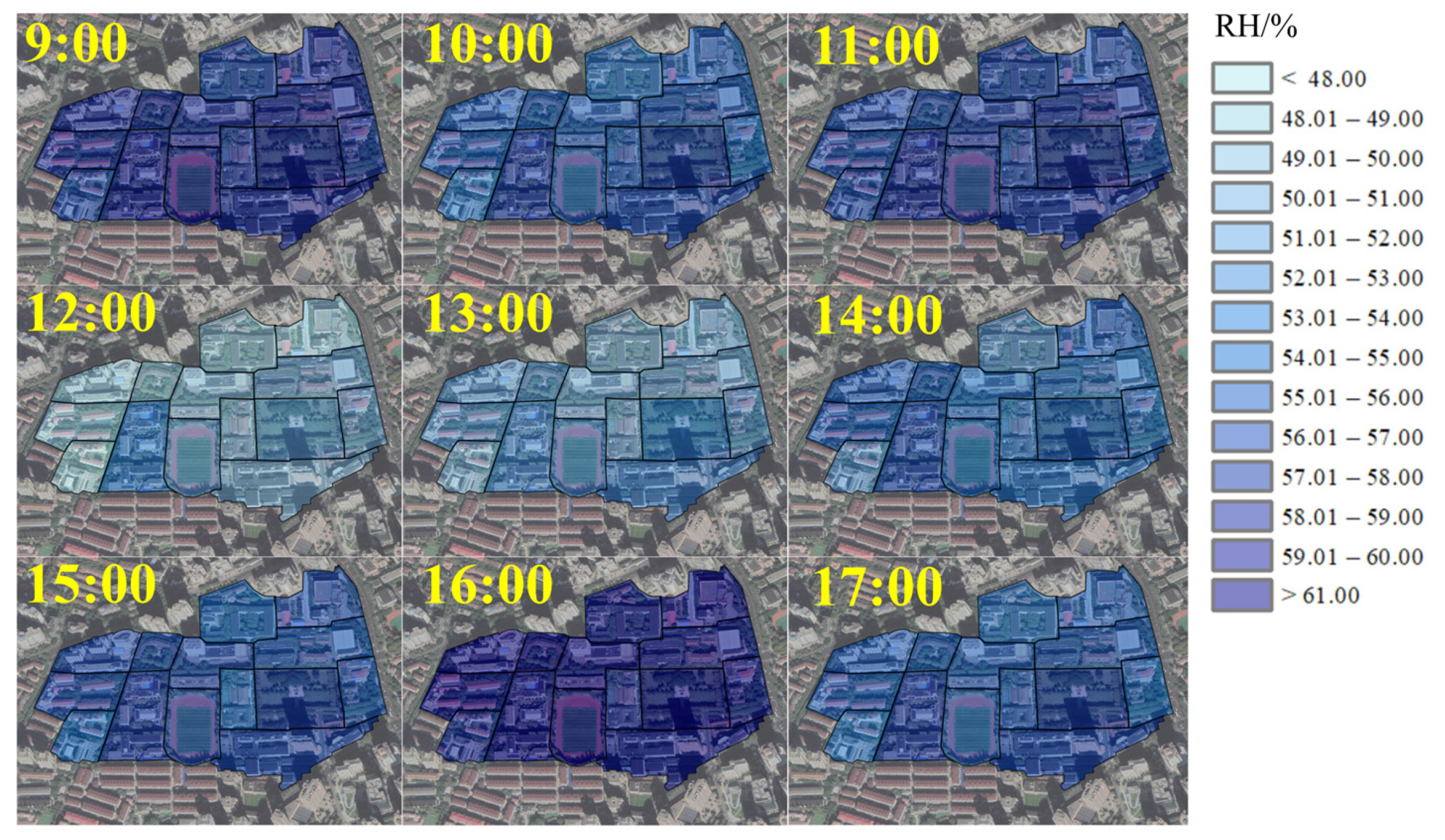
References
- Nutsford, D.; Pearson, A.L.; Kingham, S. An Ecological Study Investigating the Association between Access to Urban Green Space and Mental Health. Public Health 2013, 127, 1005–1011. [Google Scholar] [CrossRef] [PubMed]
- Wolch, J.R.; Byrne, J.; Newell, J.P. Urban Green Space, Public Health, and Environmental Justice: The Challenge of Making Cities “Just Green Enough”. Landsc. Urban Plan. 2014, 125, 234–244. [Google Scholar] [CrossRef]
- Hajrasouliha, A.; Ewing, R. Campus Does Matter: The Relationship of Student Retention and Degree Attainment to Campus Design. Plan. High. Educ. 2016, 44, 30–45. [Google Scholar]
- Shamsuddin, S.; Bahauddin, H.; Aziz, N.A. Relationship between the Outdoor Physical Environment and Student’s Social Behaviour in Urban Secondary School. Procedia-Soc. Behav. Sci. 2012, 50, 148–160. [Google Scholar] [CrossRef][Green Version]
- Hanan, H. Open Space as Meaningful Place for Students in ITB Campus. Procedia-Soc. Behav. Sci. 2013, 85, 308–317. [Google Scholar] [CrossRef]
- Rashid, M.; Obeidat, B. Students’ Static Activities in Relation to Campus Quad Design and Layout. Exploring Gender-Based Differences. J. Public Space 2020, 5, 75–94. [Google Scholar] [CrossRef]
- Alnusairat, S.; Ayyad, Y.; Al-Shatnawi, Z. Towards Meaningful University Space: Perceptions of the Quality of Open Spaces for Students. Buildings 2021, 11, 556. [Google Scholar] [CrossRef]
- Huang, Z.; Cheng, B.; Gou, Z.; Zhang, F. Outdoor Thermal Comfort and Adaptive Behaviors in a University Campus in China’s Hot Summer-Cold Winter Climate Region. Build. Environ. 2019, 165, 106414. [Google Scholar] [CrossRef]
- Lai, A.; Maing, M.; Ng, E. Observational Studies of Mean Radiant Temperature across Different Outdoor Spaces under Shaded Conditions in Densely Built Environment. Build. Environ. 2017, 114, 397–409. [Google Scholar] [CrossRef]
- Jamei, E.; Rajagopalan, P.; Seyedmahmoudian, M.; Jamei, Y. Review on the Impact of Urban Geometry and Pedestrian Level Greening on Outdoor Thermal Comfort. Renew. Sustain. Energy Rev. 2016, 54, 1002–1017. [Google Scholar]
- Achour-Younsi, S.; Kharrat, F. Outdoor Thermal Comfort: Impact of the Geometry of an Urban Street Canyon in a Mediterranean Subtropical Climate—Case Study Tunis, Tunisia. Procedia-Soc. Behav. Sci. 2016, 216, 689–700. [Google Scholar] [CrossRef]
- Liu, Y.; Li, H.; Gao, P.; Zhong, C. Monitoring the Spatiotemporal Dynamics of Urban Green Space and Its Impacts on Thermal Environment in Shenzhen City from 1978 to 2018 with Remote Sensing Data. Photogramm. Eng. Remote Sens. 2021, 87, 81–89. [Google Scholar] [CrossRef]
- Fei, F.; Wang, Y.; Yao, W.; Gao, W.; Wang, L. Coupling Mechanism of Water and Greenery on Summer Thermal Environment of Waterfront Space in China’s Cold Regions. Build. Environ. 2022, 214, 108912. [Google Scholar] [CrossRef]
- Chen, J.; Wang, H.; Zhu, H. Analytical Approach for Evaluating Temperature Field of Thermal Modified Asphalt Pavement and Urban Heat Island Effect. Appl. Therm. Eng. 2017, 113, 739–748. [Google Scholar] [CrossRef]
- Liu, X.; Cao, J.; Xin, D. Wind Field Numerical Simulation in Forested Regions of Complex Terrain: A Mesoscale Study Using WRF. J. Wind Eng. Ind. Aerodyn. 2022, 222, 104915. [Google Scholar] [CrossRef]
- Molnár, G.; Kovács, A.; Gál, T. How Does Anthropogenic Heating Affect the Thermal Environment in a Medium-Sized Central European City? A Case Study in Szeged, Hungary. Urban Clim. 2020, 34, 100673. [Google Scholar] [CrossRef]
- He, C.; Zhou, L.; Yao, Y.; Ma, W.; Kinney, P.L. Estimating Spatial Effects of Anthropogenic Heat Emissions upon the Urban Thermal Environment in an Urban Agglomeration Area in East China. Sustain. Cities Soc. 2020, 57, 102046. [Google Scholar] [CrossRef]
- Yaglou, C.P.; Minard, D. Control of Heat Casualties at Military Training Centers. AMA Arch. Ind. Health 1957, 16, 316–320. [Google Scholar]
- Ole Fanger, P. Thermal Comfort. Analysis and Applications in Environmental Engineering; Copenhagen Danish Tech. Press: Copenhagen, Denmark, 1970. [Google Scholar]
- Gagge, A.P.; Fobelets, A.P.; Berglund, L.G. Standard Predictive Index of Human Response to the Thermal Environment. ASHRAE Trans. 1986, 92, 709–731. [Google Scholar]
- Höppe, P. The Physiological Equivalent Temperature—A Universal Index for the Biometeorological Assessment of the Thermal Environment. Int. J. Biometeorol. 1999, 43, 71–75. [Google Scholar] [CrossRef]
- Jendritzky, G.; Maarouf, A.; Fiala, D.; Staiger, H. An Update on the Development of a Universal Thermal Climate Index. In Proceedings of the 15th Conference on Biometeorology and Aerobiology Joint with the 16th International Congress on Biometeorology, Kansas City, MO, USA, 28 October–1 November 2002. [Google Scholar]
- Fang, Z.; Feng, X.; Liu, J.; Lin, Z.; Mak, C.M.; Niu, J.; Tse, K.T.; Xu, X. Investigation into the Differences among Several Outdoor Thermal Comfort Indices against Field Survey in Subtropics. Sustain. Cities Soc. 2019, 44, 676–690. [Google Scholar] [CrossRef]
- Wu, J.; Liu, C.; Wang, H. Analysis of Spatio-Temporal Patterns and Related Factors of Thermal Comfort in Subtropical Coastal Cities Based on Local Climate Zones. Build. Environ. 2022, 207, 108568. [Google Scholar] [CrossRef]
- Zhang, Z.; Dong, J.; He, Q.; Ye, B. The Temporal Variation of the Microclimate and Human Thermal Comfort in Urban Wetland Parks: A Case Study of Xixi National Wetland Park, China. Forests 2021, 12, 1322. [Google Scholar] [CrossRef]
- Chen, X.; Gao, L.; Xue, P.; Du, J.; Liu, J. Investigation of Outdoor Thermal Sensation and Comfort Evaluation Methods in Severe Cold Area. Sci. Total Environ. 2020, 749, 141520. [Google Scholar] [CrossRef]
- Othman, N.E.; Zaki, S.A.; Rijal, H.B.; Ahmad, N.H.; Razak, A.A. Field Study of Pedestrians’ Comfort Temperatures under Outdoor and Semi-Outdoor Conditions in Malaysian University Campuses. Int. J. Biometeorol. 2021, 65, 453–477. [Google Scholar] [CrossRef]
- Niu, J.; Hong, B.; Geng, Y.; Mi, J.; He, J. Summertime Physiological and Thermal Responses among Activity Levels in Campus Outdoor Spaces in a Humid Subtropical City. Sci. Total Environ. 2020, 728, 138757. [Google Scholar] [CrossRef]
- Jin, H.; Qiao, L.; Cui, P. Study on the Effect of Streets’ Space Forms on Campus Microclimate in the Severe Cold Region of China—Case Study of a University Campus in Daqing City. Int. J. Environ. Res. Public Health 2020, 17, 8389. [Google Scholar] [CrossRef]
- Taleghani, M. The Impact of Increasing Urban Surface Albedo on Outdoor Summer Thermal Comfort within a University Campus. Urban Clim. 2018, 24, 175–184. [Google Scholar] [CrossRef]
- Ma, X.; Zhang, L.; Zhao, J.; Wang, M.; Cheng, Z. The Outdoor Pedestrian Thermal Comfort and Behavior in a Traditional Residential Settlement—A Case Study of the Cave Dwellings in Cold Winter of China. Sol. Energy 2021, 220, 130–143. [Google Scholar] [CrossRef]
- Lai, D.; Guo, D.; Hou, Y.; Lin, C.; Chen, Q. Studies of Outdoor Thermal Comfort in Northern China. Build. Environ. 2014, 77, 110–118. [Google Scholar] [CrossRef]
- Yang, W.; Wong, N.H.; Zhang, G. A Comparative Analysis of Human Thermal Conditions in Outdoor Urban Spaces in the Summer Season in Singapore and Changsha, China. Int. J. Biometeorol. 2013, 57, 895–907. [Google Scholar] [CrossRef] [PubMed]
- Abdollahzadeh, N.; Biloria, N. Outdoor Thermal Comfort: Analyzing the Impact of Urban Configurations on the Thermal Performance of Street Canyons in the Humid Subtropical Climate of Sydney. Front. Arch. Res. 2020, 10, 394–409. [Google Scholar] [CrossRef]
- Matzarakis, A.; Rutz, F.; Mayer, H. Modelling Radiation Fluxes in Simple and Complex Environments: Basics of the RayMan Model. Int. J. Biometeorol. 2010, 54, 131–139. [Google Scholar] [CrossRef]
- Stewart, I.D.; Oke, T.R. Local Climate Zones for Urban Temperature Studies. Bull. Am. Meteorol. Soc. 2012, 93, 1879–1900. [Google Scholar] [CrossRef]
- Liu, L.; Lin, Y.; Liu, J.; Wang, L.; Wang, D.; Shui, T.; Chen, X.; Wu, Q. Analysis of Local-Scale Urban Heat Island Characteristics Using an Integrated Method of Mobile Measurement and GIS-Based Spatial Interpolation. Build. Environ. 2017, 117, 191–207. [Google Scholar] [CrossRef]
- Oliveira, A.V.M.; Raimundo, A.M.; Gaspar, A.R.; Quintela, D.A. Globe Temperature and Its Measurement: Requirements and Limitations. Ann. Work. Expo. Health 2019, 63, 743–758. [Google Scholar] [CrossRef]
- Lam, C.K.C.; Cui, S.; Liu, J.; Kong, X.; Ou, C.; Hang, J. Influence of Acclimatization and Short-Term Thermal History on Outdoor Thermal Comfort in Subtropical South China. Energy Build. 2021, 231, 110541. [Google Scholar] [CrossRef]
- ANSI/ASHRAE ANSI/ASHRAE Standard 55-2017; Thermal Environmental Conditions for Human Occupancy. ASHRAE Inc.: Atlanta, GA, USA, 2017.
- Teitelbaum, E.; Alsaad, H.; Aviv, D.; Kim, A.; Voelker, C.; Meggers, F.; Pantelic, J. Addressing a Systematic Error Correcting for Free and Mixed Convection When Measuring Mean Radiant Temperature with Globe Thermometers. Sci. Rep. 2022, 12, 6473. [Google Scholar] [CrossRef]
- Bernard, J.; Bocher, E.; Petit, G.; Palominos, S. Sky View Factor Calculation in Urban Context: Computational Performance and Accuracy Analysis of Two Open and Free GIS Tools. Climate 2018, 6, 60. [Google Scholar] [CrossRef]
- Liu, L.; Lin, Y.; Wang, D.; Liu, J. An Improved Temporal Correction Method for Mobile Measurement of Outdoor Thermal Climates. Arch. Meteorol. Geophys. Bioclimatol. Ser. B 2017, 129, 201–212. [Google Scholar] [CrossRef]
- Liu, W.; Zhang, Y.; Deng, Q. The Effects of Urban Microclimate on Outdoor Thermal Sensation and Neutral Temperature in Hot-Summer and Cold-Winter Climate. Energy Build. 2016, 128, 190–197. [Google Scholar] [CrossRef]
- Ye, X.; Chen, F.; Hou, Z. The Effect of Temperature on Thermal Sensation: A Case Study in Wuhan City, China. Procedia Eng. 2015, 121, 2149–2156. [Google Scholar] [CrossRef]
- Liu, L.; Lin, Y.; Wang, D.; Liu, J. Quantitative Analysis of the Outdoor Thermal Comfort in the Hot and Humid Summertime of Shenzhen, China. J. Harbin Inst. Technol. 2017, 24, 30–38. [Google Scholar] [CrossRef]
- Lin, T.P.; Matzarakis, A. Tourism Climate and Thermal Comfort in Sun Moon Lake, Taiwan. Int. J. Biometeorol. 2008, 52, 281–290. [Google Scholar] [CrossRef]
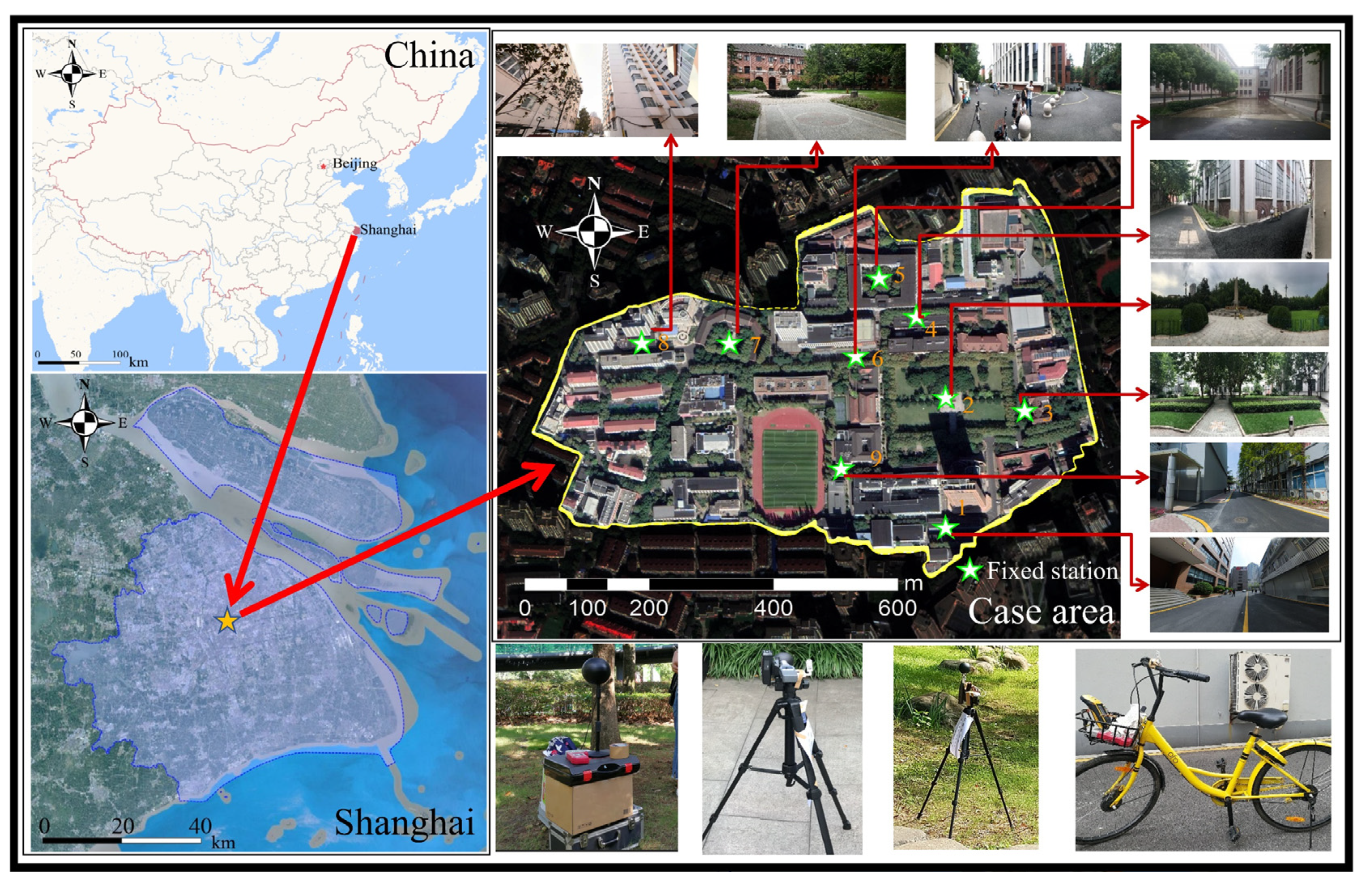

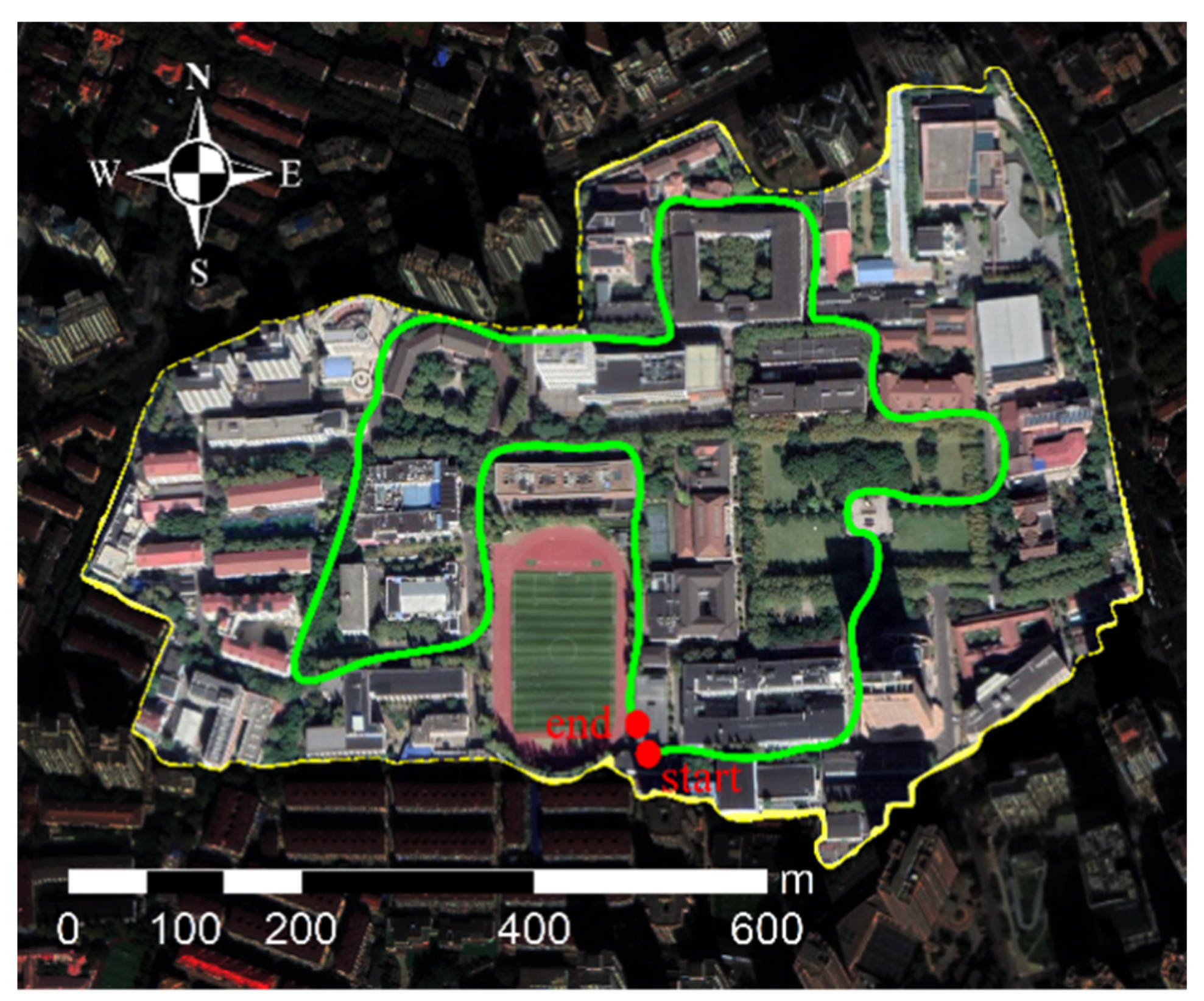
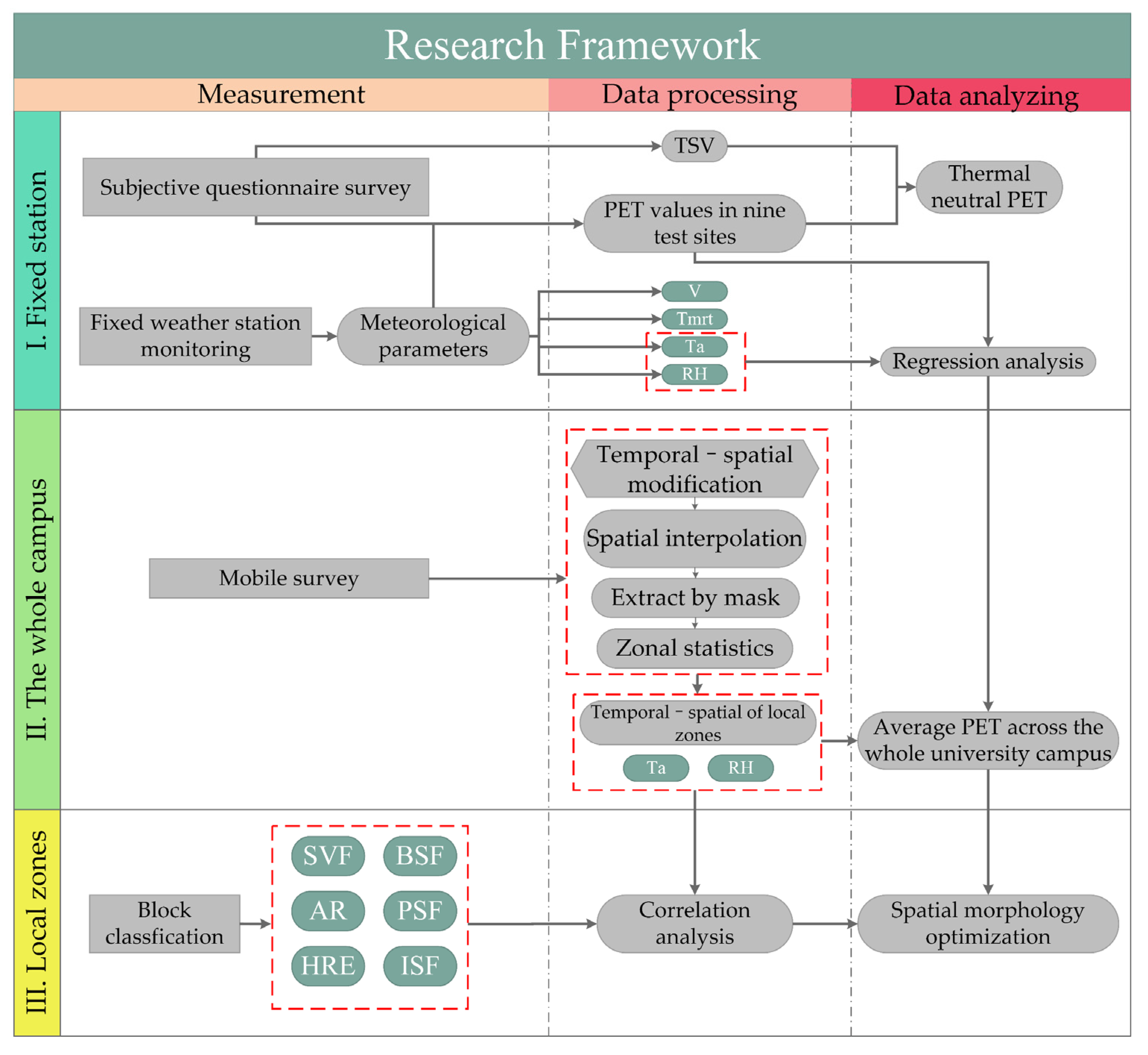

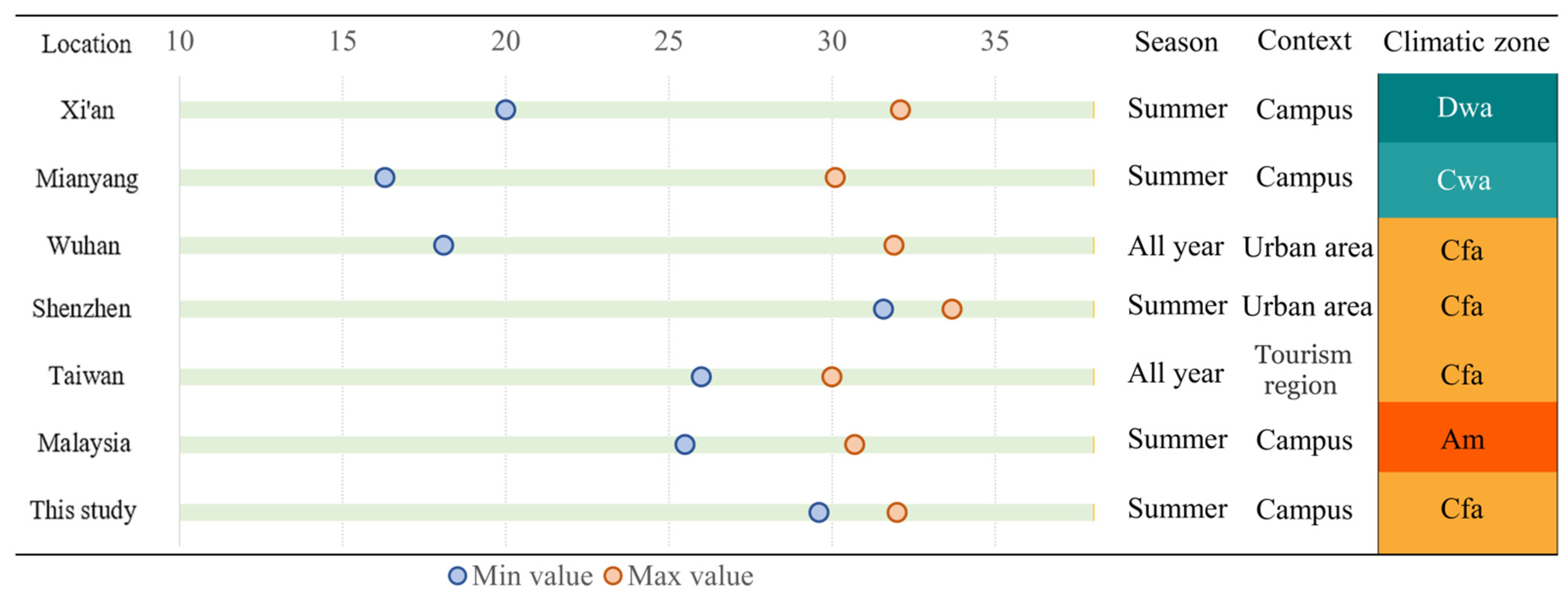
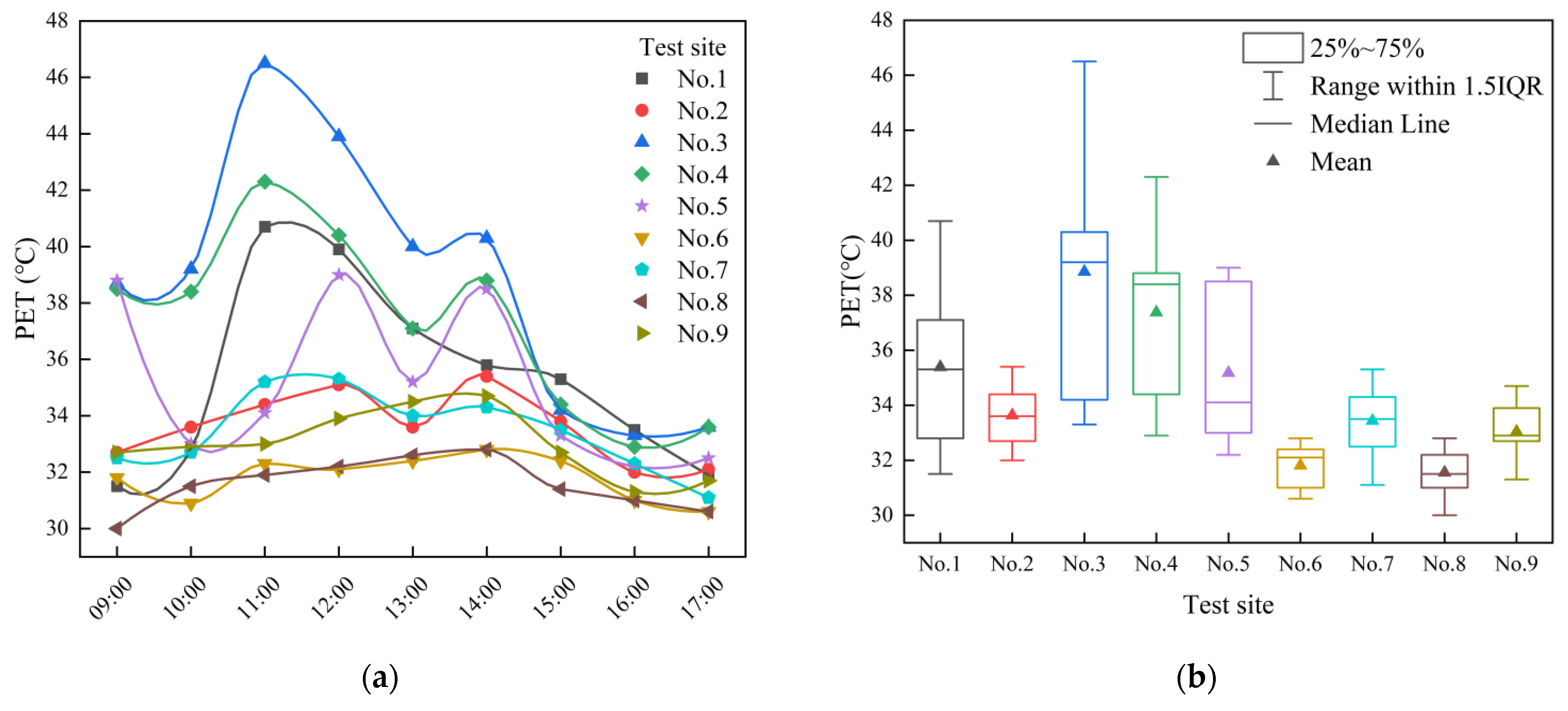
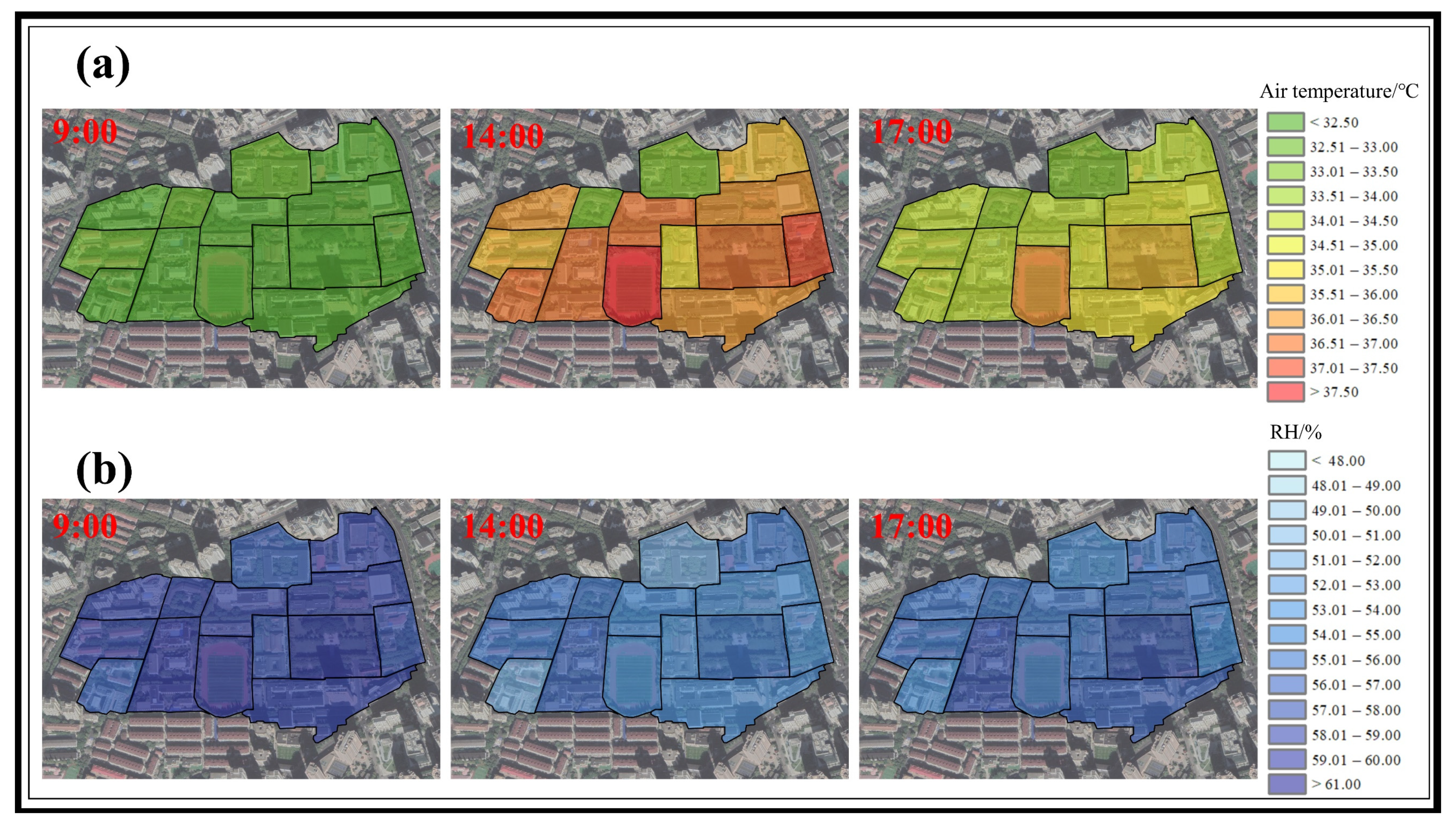
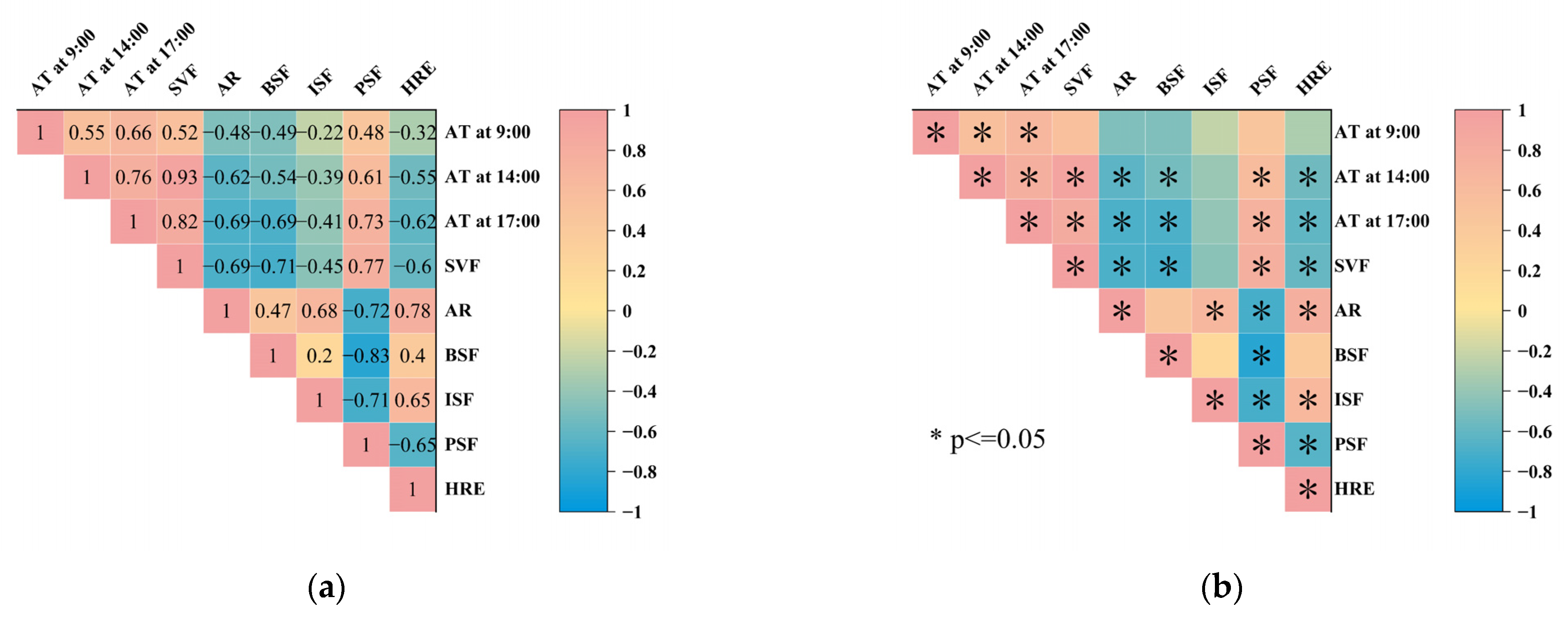
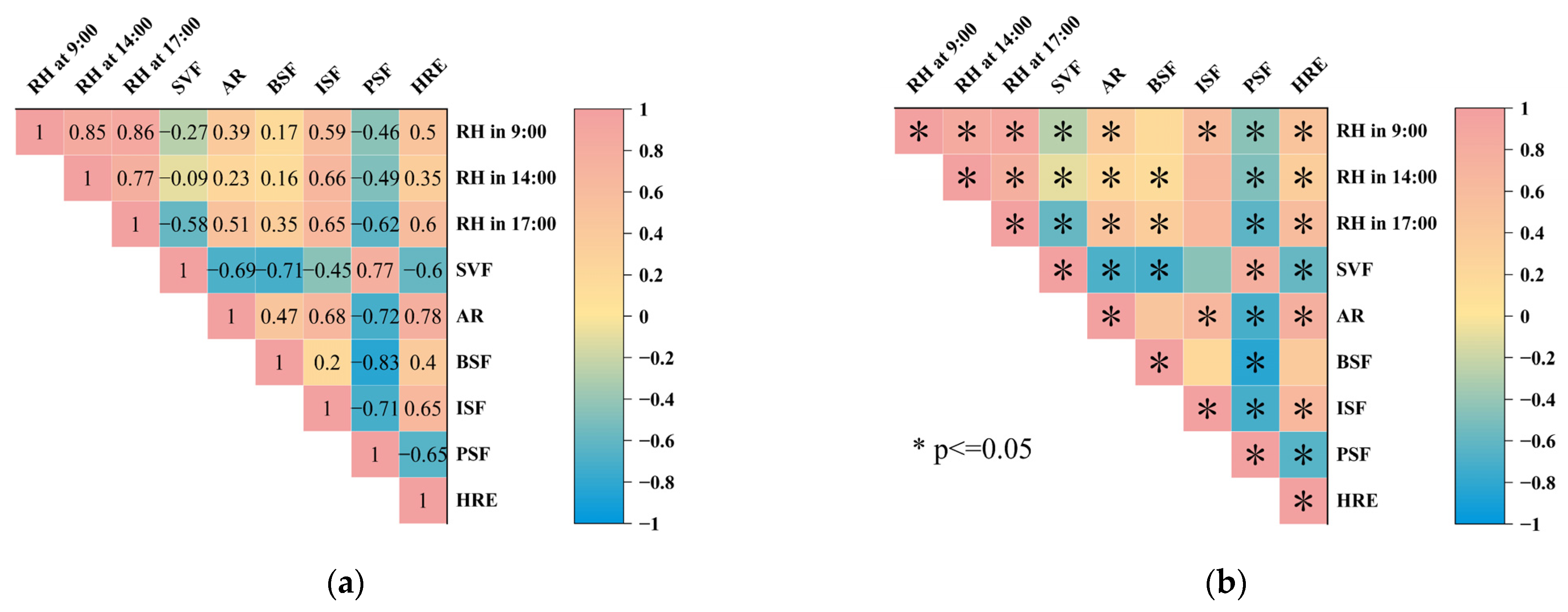
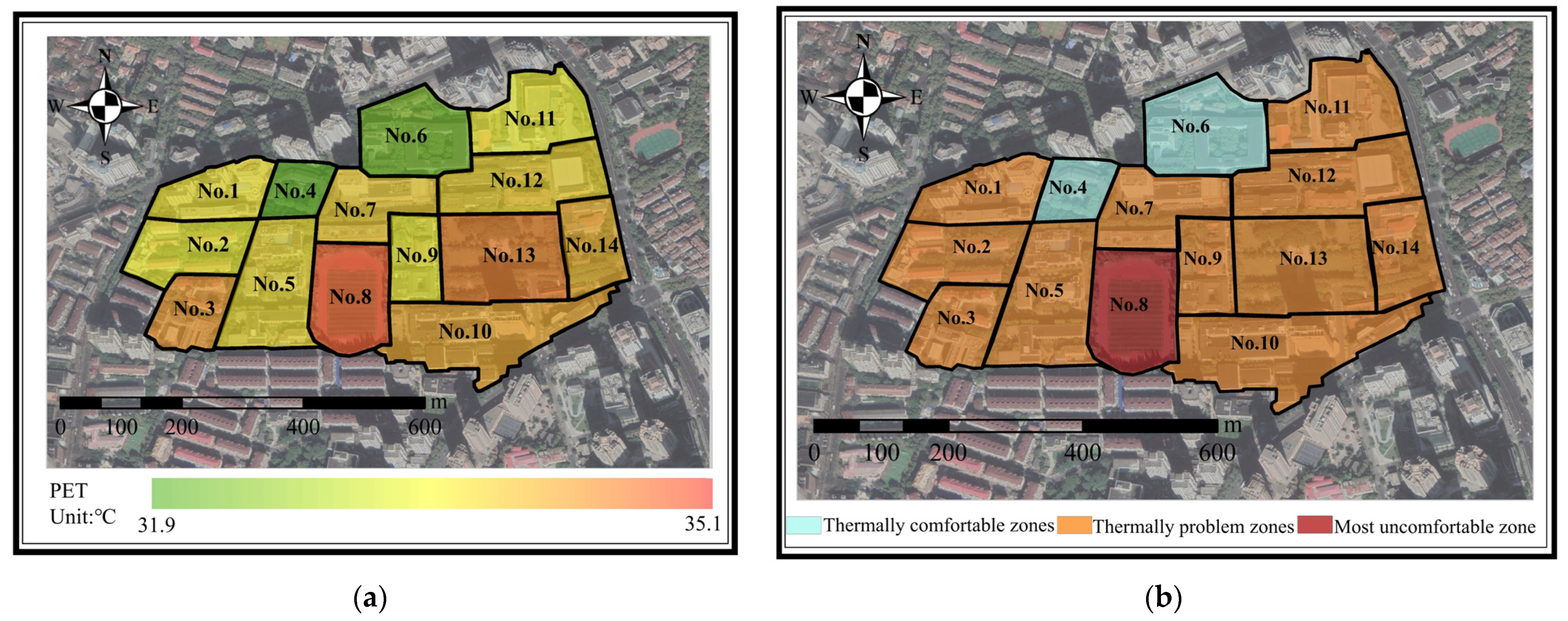
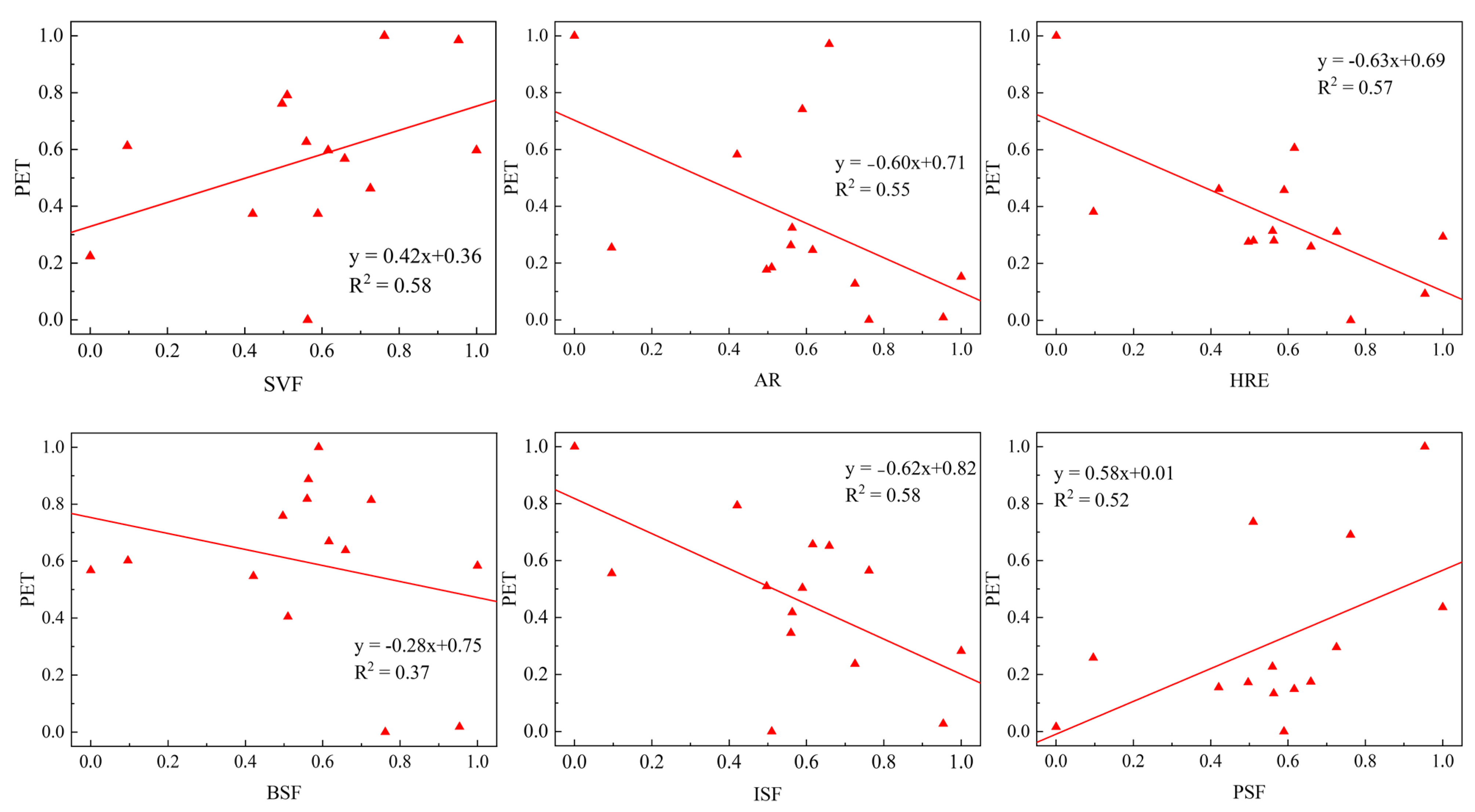
| Month | Mean Ta (°C) | Max. Ta (°C) | Min. Ta (°C) | Mean RH (%) | Mean V (m/s) |
|---|---|---|---|---|---|
| January | 4.8 | 6.8 | 1.5 | 68 | 2.5 |
| February | 6.4 | 7.5 | 4.4 | 72 | 2.7 |
| March | 10.3 | 11.5 | 9.3 | 68 | 2.9 |
| April | 15.7 | 17.5 | 12.8 | 67 | 3.0 |
| May | 21.1 | 21.7 | 20.5 | 69 | 2.9 |
| June | 24.0 | 24.3 | 23.3 | 79 | 2.6 |
| July | 29.2 | 32.0 | 26.7 | 72 | 2.8 |
| August | 28.9 | 31.0 | 26.3 | 73 | 3.0 |
| September | 24.6 | 26.2 | 23.7 | 74 | 2.8 |
| October | 19.8 | 20.8 | 19.1 | 70 | 2.6 |
| November | 14.1 | 16.7 | 12.2 | 72 | 2.4 |
| December | 7.0 | 9.1 | 5.7 | 67 | 2.6 |
| Instruments | Parameters | Measurement Range | Accuracy |
|---|---|---|---|
| JTR08C (temperature/humidity data logger) | Air temperature/°C RH/% | −40–100 °C(Ta) 0–100%(RH) | ±0.2 °C <±5% |
| ZRQF (hot bulb anemometer) | Wind speed/m·s−1 | 0.05–30 m/s | ±(4% ± 0.05) |
| JTR04 (globe temperature logger) | Globe temperature/°C | 5–120 °C | ±0.2 °C |
| Parameters | Collection Methods | Calculation Formula | Explanation |
|---|---|---|---|
| SVF | Calculating through SAGA-GIS [42] | is the building height of is the width of the street canyon, m; | |
| AR | Building a 3D model combined with field investigation | H is the height of the zone, m; W is the width of street canyon in the zone, m; | |
| HRE/m | Building a 3D model combined with field investigation | is the height of the building in a zone, m; n is the number of buildings in the zone; | |
| BSF/% | Building infographic through Google Earth satellite imagery and mapping software | is the total area of the zone; | |
| PSF/% | Collecting through Google Earth Satellite Images | is the total area of the zone, m2; | |
| ISF/% | Collecting through Google Earth Satellite Images | is the total area of the zone, m2; |
| Test Site No. | Amount of Subjects | Gender | Mean Age | Mean BMI | Mean Clothing Thermal Resistance/(clo) | Mean Metabolic Rate/(W/m2) | |
|---|---|---|---|---|---|---|---|
| Male | Female | ||||||
| 1 | 40 | 20 | 20 | 18.2 | 19.5 | 0.48 | 170.0 |
| 2 | 41 | 19 | 22 | 23.7 | 24.2 | 0.47 | 150.9 |
| 3 | 37 | 19 | 18 | 23.1 | 23.0 | 0.50 | 142.9 |
| 4 | 49 | 25 | 24 | 19.6 | 21.4 | 0.50 | 143.2 |
| 5 | 55 | 28 | 27 | 21.7 | 21.5 | 0.46 | 141.4 |
| 6 | 59 | 29 | 30 | 20.6 | 21.1 | 0.51 | 112.7 |
| 7 | 62 | 31 | 31 | 22.7 | 21.4 | 0.51 | 130.9 |
| 8 | 50 | 25 | 25 | 18.7 | 24.0 | 0.50 | 136.9 |
| 9 | 48 | 24 | 24 | 19.3 | 22.3 | 0.47 | 109.2 |
| No. | Ta (°C) | RH (%) | V (m/s) | Tmrt (°C) | ||||||||
|---|---|---|---|---|---|---|---|---|---|---|---|---|
| Mean | Max | Min | Mean | Max | Min | Mean | Max | Min | Mean | Max | Min | |
| 1 | 31.1 | 32.3 | 30.2 | 57.1 | 63 | 50 | 0.6 | 1.2 | 0.2 | 38.2 | 52.9 | 30.8 |
| 2 | 31.1 | 31.9 | 30.4 | 58.4 | 65 | 51 | 0.4 | 1.1 | 0 | 36.9 | 46.1 | 30.3 |
| 3 | 32.2 | 34.1 | 31.3 | 52.2 | 57 | 46 | 0.6 | 1.2 | 0 | 41.7 | 58.2 | 31.9 |
| 4 | 33.1 | 36.1 | 32 | 47.3 | 55 | 39 | 0.4 | 0.8 | 0 | 40.7 | 51.1 | 31.7 |
| 5 | 33.2 | 34.9 | 32.4 | 50.2 | 58 | 43 | 0.4 | 0.9 | 0.1 | 37 | 43.8 | 32 |
| 6 | 33.5 | 35.6 | 32.1 | 49.8 | 58 | 43 | 0.5 | 1.1 | 0.2 | 38.4 | 45.8 | 32.3 |
| 7 | 32.4 | 33.3 | 31.6 | 53.3 | 61 | 47 | 0.9 | 1.2 | 0 | 35.3 | 40.3 | 31 |
| 8 | 31.6 | 32.4 | 30.9 | 56 | 61 | 51 | 0.5 | 1.5 | 0 | 32.9 | 34.7 | 30.2 |
| 9 | 31.5 | 33 | 30.1 | 54.9 | 62 | 48 | 0.6 | 1.1 | 0 | 32.7 | 35.7 | 29.5 |
Publisher’s Note: MDPI stays neutral with regard to jurisdictional claims in published maps and institutional affiliations. |
© 2022 by the authors. Licensee MDPI, Basel, Switzerland. This article is an open access article distributed under the terms and conditions of the Creative Commons Attribution (CC BY) license (https://creativecommons.org/licenses/by/4.0/).
Share and Cite
Liu, L.; Liang, Z.; Liu, J.; Du, J.; Zhang, H. Field Survey on Local Thermal Comfort of Students at a University Campus: A Case Study in Shanghai. Atmosphere 2022, 13, 1433. https://doi.org/10.3390/atmos13091433
Liu L, Liang Z, Liu J, Du J, Zhang H. Field Survey on Local Thermal Comfort of Students at a University Campus: A Case Study in Shanghai. Atmosphere. 2022; 13(9):1433. https://doi.org/10.3390/atmos13091433
Chicago/Turabian StyleLiu, Lin, Zhenxi Liang, Jing Liu, Jing Du, and Huibo Zhang. 2022. "Field Survey on Local Thermal Comfort of Students at a University Campus: A Case Study in Shanghai" Atmosphere 13, no. 9: 1433. https://doi.org/10.3390/atmos13091433
APA StyleLiu, L., Liang, Z., Liu, J., Du, J., & Zhang, H. (2022). Field Survey on Local Thermal Comfort of Students at a University Campus: A Case Study in Shanghai. Atmosphere, 13(9), 1433. https://doi.org/10.3390/atmos13091433









